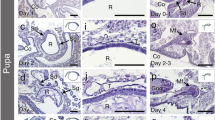Abstract
The bulbus is a part of the unique functional penis (endophallus) in the genus Apis and was studied in Apis mellifera drones. The bulbus consists of a thin cuticular membrane, covered by four different epithelia (dorsal epithelium, anterior epithelium, ventral epithelium I and ventral epithelium II). One day before eclosion, pupae have no sclerotised plates in the bulbus lumen. In emerging drones, however, the lumen contains tanned plate-like structures, the chitin plates, subjacent are small droplets. The chitin plates are connected to each other by a transparent matrix. They consist of globular sclerotized structures which are connected by a network of fibrils. In young adult drones, the dorsal and lateral epithelia consist of highly columnar gland cells which decrease in thickness from the age of 6–12 days from 140 to 20 μm. The ultrastructural analysis combined with histochemistry shows that the gland cells secrete proteinaceous droplets towards the lumen which pass through the cuticle and the pores of the chitin plates and accumulate in the matrix. In sexually mature drones, all secretions have merged to a rigid connective substance, which extends laterally as a thin tapering membrane. The ventral epithelia I and II have no secretory function. The ventral epithelium II has a mucus-like content and several invaginations towards the lumen of the bulbus which enables widening of the bulbus orifice to discharge the bulbus secretions filled with viscous mucus via the cervix into the queen during the mating process.










Similar content being viewed by others
References
Bancroft, J.D., Gamble, M. (2008) Theory and practice of histological techniques, 6th edn. Churchill Livingstone, Philadelphia
Colonello, N.A., Hartfelder, K. (2003) Protein content and pattern during mucus gland maturation and its ecdysteroid control in honeybee drones. Apidologie 34, 1–10
Colonello, N.A., Hartfelder, K. (2005) She’s my girl—male accessory gland products and their function in the reproductive biology of social bees. Apidologie 36, 231–244
Gary N.E. (1969) Mating behaviour of the honeybee. Proc. XXII Int. Beekeep. Congr., 413–414
Gillott, C. (1988) Arthropoda–Insecta. In: Adiyodi, K.G., Adiyodi, R.G. (eds.) Reproductive biology of invertebrates, vol. 3, pp. 319–471. Wiley, Chichester
Gillott, C. (1996) Male insect accessory glands: functions and control of secretory activity. Invertebr. Repr. Dev. 30, 199–205
Gillott, C. (2003) Male accessory gland secretions: modulators of female reproductive physiology and behavior. Annu. Rev. Entomol. 48, 163–184
Koeniger, G. (1984) Funktionsmorphologische Befunde bei der Kopulation der Honigbiene (Apis mellifera L.). Apidologie 15, 189–204
Koeniger, G. (1986) Mating sign and multiple mating in the honeybee. Bee World 67, 141–150
Koeniger, G. (1990) The role of the mating sign in honeybees Apis mellifera L.: does it hinder or promote multiple mating? Anim. Behav. 39, 444–449
Koeniger, G., Hänel, H. (1996) The bulbus gland of drones (Apis mellifera L.). Pszcz. Zesz. Nauk. 2, 45–54
Koeniger, G., Hänel, H., Wissel, M., Herth, W. (1996) Cornual gland in the honeybee drone (Apis mellifera L.): structure and secretion. Apidologie 27, 145–156
Koeniger, G., Koeniger, N., Mardan, M., Otis, G., Wongsiri, S. (1991) Comparative anatomy of male genital organs in the genus Apis. Apidologie 22, 539–552
Leopold, R.A. (1976) The role of male accessory glands in insect reproduction. Annu. Rev. Entomol. 21, 199–221
Moors, L., Billen, J. (2009) Age-dependent morphology and ultrastructure of the cornua glands in drones of Apis mellifera. Apidologie 40, 600–607
Moors, L., Spaas, O., Koeniger, G., Billen, J. (2005) Morphological and ultrastructural changes in the mucus glands of Apis mellifera drones during pupal development and sexual maturation. Apidologie 36, 245–254
Patinawin, S., Wongsiri, S. (1993) Male genitalia of honeybees in Asian apiculture. Proc. 1st Int. Conf. Asian Honeybees and Bee Mites, Bangkok, Thailand. Wicwas Press, Cherhire, CT, USA, pp. 110–116
Snodgrass, R.E. (1941) The male genitalia of Hymeno-ptera. Smithsonian Institution, Washington
Snodgrass, R.E. (1956) Anatomy of the honey bee. Comstock Publ. Assoc. Cornell. Univ. Press, Ithaca
Winston, M.L. (1987) The biology of the honey bee. Harvard University Press, Cambridge
Wolfner, M.F. (1997) Tokens of love: functions and regulation of Drosophila melanogaster male accessory gland products. Insect Biochem. Mol. Biol. 27, 179–192
Woyke, J. (1956) Anatomo-physiological changes in queen-bees returning from mating flights and the process of multiple mating. Bull. Acad. Polon. Sci. 4, 81–87
Woyke, J. (1958a) The process of mating in the honeybee. Pszcz. Zesz. Nauk. 2, 1–42
Woyke, J. (1958b) The histological structure of the reproductive organs of the drone. Publ. Sect. Agr. Sylv. 19, 38–50
Woyke, J., Ruttner, F. (1958) An anatomical study of the mating process in the honeybee. Bee World 39, 3–18
Woyke, J. (2008) Why the eversion of the endophallus of honey bee drone stops at the partly everted stage and significance of this. Apidologie 39, 627–636
Zander, E. (1916) Die postembryonale Entwicklung des Geschlechtsapparates der Drohne (Apis mellifica L.). Z. Angew. Ent. 3, 7–20
Zander, E. (1922) Der Bau der Biene. E. Ulmer, Stuttgart
Author information
Authors and Affiliations
Corresponding author
Additional information
Manuscript editor: Klaus Hartfelder
Ontogénie et morphologie du bulbe, partie de l’organe reproducteur mâle chez Apis mellifera carnica (Hymenoptera, Apidae)
Morphologie / ontogénie / ultrastructure / bulbe / endophallus / abeille / mâle
Entwicklung und Morphologie des Bulbus, eines Teils des männlichen Reproduktionstrakts von Apis mellifera carnica (Hymenoptera, Apidae)
Morphologie / Entwicklung / Ultrastruktur / BUlbus / Endophallus / Honigbiene / Drohn
Rights and permissions
About this article
Cite this article
Moors, L., Koeniger, G. & Billen, J. Ontogeny and morphology of the bulbus, part of the male reproductive organ in Apis mellifera carnica (Hymenoptera, Apidae). Apidologie 43, 201–211 (2012). https://doi.org/10.1007/s13592-011-0094-9
Received:
Revised:
Accepted:
Published:
Issue Date:
DOI: https://doi.org/10.1007/s13592-011-0094-9




